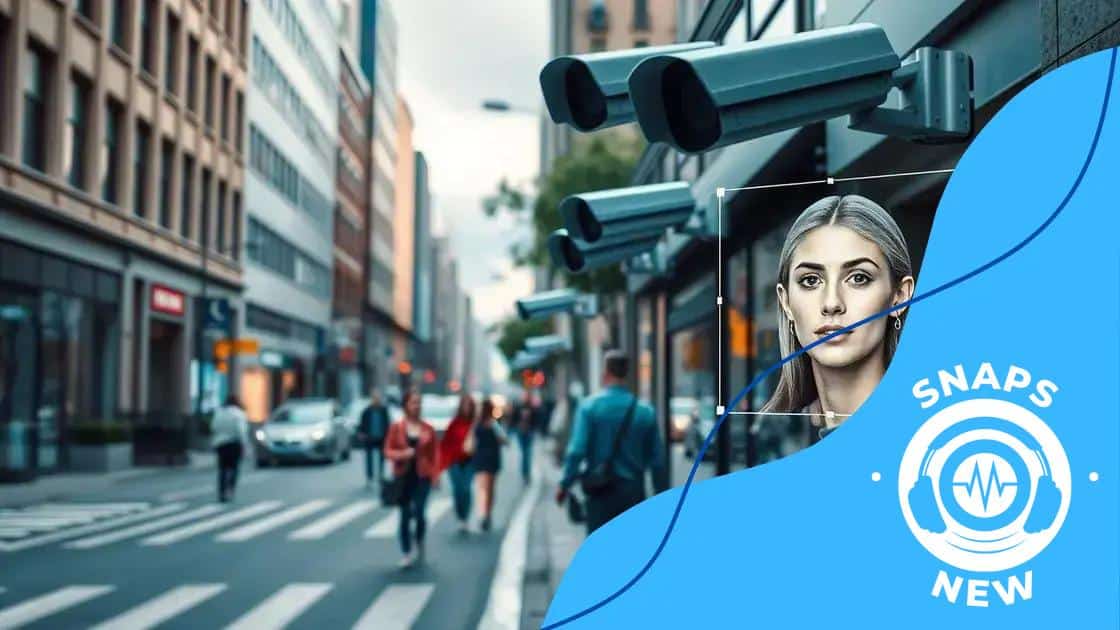The role of facial recognition in enhancing public safety

The role of facial recognition in enhancing public safety involves using technology to identify individuals quickly, aiding law enforcement and increasing security while addressing ethical concerns like privacy and bias.
The role of facial recognition in enhancing public safety has become a pivotal topic in today’s security landscape. More effective than traditional methods, it’s reshaping how we think about safety in public spaces.
Understanding facial recognition technology
Understanding facial recognition technology is essential in our digital age. This advanced technology uses algorithms to identify and verify individuals by analyzing facial features. It’s becoming increasingly prevalent in various industries, especially in public safety.
Facial recognition systems capture images through cameras and compare them to a database of known faces. This process relies on detailed measurements of features, such as the distance between the eyes, nose shape, and jawline structure. Such precision allows for accurate identification.
How it Works
These systems are designed to function efficiently under different conditions. Factors like lighting, angle, and image quality can affect performance, but technological advancements are continually improving accuracy.
- Image Capture: The technology captures a photo or video.
- Feature Extraction: It identifies specific facial features.
- Comparison: The features are matched against a database.
- Result: The system confirms or denies identity.
The application of facial recognition technology extends beyond simple identification. For law enforcement, it serves as a powerful tool in criminal investigations and missing persons cases. For instance, police departments use it to analyze footage and identify suspects efficiently.
Challenges and Limitations
While the benefits are clear, challenges exist. Misidentifications can occur, especially in cases of poor image quality or similar-looking individuals. Concerns about privacy and ethical implications are also significant. Ensuring that usage remains transparent and accountable is crucial.
As this technology continues evolving, it’s important to engage in conversations about its ethical use and the implications for society. Understanding facial recognition technology helps us appreciate its potential while remaining vigilant about its challenges.
How facial recognition aids police investigations
How facial recognition aids police investigations is a crucial aspect of modern law enforcement. This technology provides officers with powerful tools to identify and track suspects effectively. By analyzing images from surveillance cameras, police can quickly match faces to those in their databases.
Using this technology significantly speeds up investigations. Instead of relying solely on witness statements, officers can use facial recognition to gather evidence. This technique is particularly useful in crowded places where a suspect might have slipped away unnoticed.
Real-World Applications
Many police departments have implemented facial recognition systems. These systems allow for real-time monitoring in public spaces, enhancing security and safety. For example, if a crime occurs, footage can be swiftly examined to find the perpetrator.
- Identification of Suspects: Quickly locate individuals involved in criminal activities.
- Missing Persons Cases: Aid in finding missing individuals by matching facial features against databases.
- Preventing Crime: Deter criminal activities with the knowledge that facial recognition technology is in use.
Moreover, the adoption of facial recognition technology has led to the arrest of several high-profile criminals. In many cases, it has been instrumental in solving cold cases that remained unresolved for years. This technology operates on a premise that identifies patterns and highlights discrepancies in suspected cases.
Potential Concerns
While the benefits are substantial, there are also concerns. Issues like privacy violations and misidentification are at the forefront of discussions about its use. It raises questions about civil liberties and the ethics of surveillance. Balancing the effectiveness of technology with respect for individual rights is essential.
As law enforcement continues to evolve with technology, understanding how facial recognition aids investigations will be critical for both officers and the public.
Ethical concerns surrounding facial recognition

Ethical concerns surrounding facial recognition are a critical topic in the discussion of this technology’s use. As it becomes more widespread in law enforcement and public safety, many questions arise about the balance between security and privacy rights.
One major issue is the potential for misidentification. If the technology fails to accurately recognize individuals, it can lead to wrongful accusations. This can have severe consequences for innocent people. Ensuring the accuracy of facial recognition systems is essential to prevent such incidents.
Privacy Violations
Another concern is the invasion of privacy. With cameras and facial recognition technology in public spaces, people may feel constantly watched. This constant surveillance can create a chilling effect, discouraging free expression and movement. Society must consider how much surveillance is acceptable in the name of safety.
- Data Storage: How long will images be stored?
- Consent: Are individuals aware they are being scanned?
- Access: Who can access this data?
Moreover, there are issues regarding data security. Biometric data is sensitive and can lead to identity theft if it falls into the wrong hands. Protecting this data is crucial as its misuse could have catastrophic implications.
Discrimination and Bias
Facial recognition technology may also amplify existing biases. Research shows that some systems perform poorly on individuals with darker skin tones. This can lead to disproportionate targeting of certain communities by law enforcement. Addressing these biases is vital to ensure fair treatment for all citizens.
The discussion surrounding ethical concerns emphasizes the need for regulations and guidelines. Policymakers must create frameworks to govern the use of facial recognition technology, ensuring it is used responsibly without infringing on individual rights.
Real-world examples of successful implementations
Real-world examples of successful implementations of facial recognition technology showcase its impact on public safety and law enforcement. Various cities and agencies have successfully adopted this technology to improve security efforts.
One notable implementation is in London, where facial recognition cameras monitor busy areas. The Metropolitan Police have used this system to identify suspects in real-time, which has led to quicker arrests. By analyzing footage from crowded locations, law enforcement can respond faster than ever.
Case Study: Missing Persons
Another effective use of facial recognition has been in finding missing persons. In 2020, a police department in Florida utilized this technology to reunite families with missing children. By scanning crowds at events and comparing faces against their database, investigators successfully located several missing individuals.
- Faster identification: Quick match to databases saves time.
- Increased resolution on cold cases: Solves previously unsolvable cases.
- Enhanced safety at large events: Monitors safety in real-time during public gatherings.
Moreover, in China, facial recognition is used for tracking and preventing crime. The technology integrates with the country’s extensive surveillance system, allowing police to monitor suspicious activities effectively. This proactive approach has drastically reduced crime rates in certain areas.
Public Events and Security
Events such as concerts and sports games have also benefited from facial recognition technology. Security teams use this technology to identify known threats in the crowd. The result is a safer environment for attendees, where immediate action can be taken against potential risks.
These successful implementations demonstrate that when used responsibly, facial recognition technology can significantly enhance public safety efforts. With proper oversight, its benefits can be maximized while minimizing potential downsides.
The future of facial recognition in public safety
The future of facial recognition in public safety is promising as technology continues to advance. Over the next few years, we can expect significant improvements in accuracy and application. This technology will play an even bigger role in enhancing security measures worldwide.
One major area of growth is the integration of artificial intelligence with facial recognition systems. AI can analyze patterns and behaviors, making it easier to identify potential threats. As algorithms improve, the chances of misidentification will decrease, leading to greater trust in the technology.
Expanded Applications
Facial recognition technology is likely to expand into various fields beyond security. It can aid in access control, verifying identity at airports, or even in our smartphones. Healthcare and retail might also adopt this technology to provide personalized customer experiences.
- Smart Cities: Integration with urban infrastructure for better traffic management.
- Enhanced Security: Real-time alerts for suspicious activity in public spaces.
- Improved Personalization: Tailoring services based on individual preferences.
Moreover, as privacy regulations evolve, developers will find new ways to ensure data protection. Balancing the benefits of facial recognition with ethical considerations will be essential. Companies will likely adopt measures to be more transparent, ensuring the public understands how their data is used.
Public Perception and Acceptance
Another aspect influencing the future is public perception. Educating the community on how facial recognition technology works can foster acceptance. Addressing concerns about privacy and misuse will be crucial in gaining public trust. As people become more informed, they may see the potential benefits for safety and security.
In summary, the future of facial recognition in public safety is bright. With advancements in technology, ethical considerations, and public awareness, it has the potential to transform how we approach safety measures in our communities.
Conclusion: The role of facial recognition technology in public safety continues to evolve. As we look to the future, advancements in AI and ethical practices will enhance its effectiveness while addressing concerns about privacy and bias. Public education and transparency are key to gaining community trust. By finding the right balance, we can harness the benefits of this powerful tool while respecting individual rights and freedoms.
FAQ – Frequently Asked Questions about Facial Recognition in Public Safety
What is facial recognition technology?
Facial recognition technology uses algorithms to analyze facial features in images or videos to identify individuals.
How does facial recognition aid law enforcement?
It helps law enforcement quickly identify suspects and victims by comparing facial data against existing databases.
What are some ethical concerns regarding facial recognition?
Concerns include potential privacy violations, misidentification, and biases in the technology affecting certain groups.
What does the future hold for facial recognition in public safety?
The future may see enhanced accuracy, wider applications, and improved public acceptance through transparency and ethical practices.





